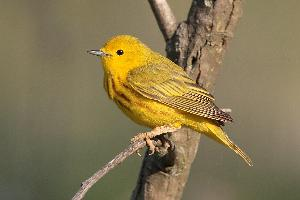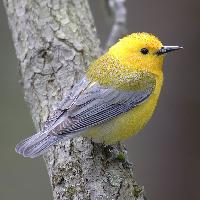
Váhy a míry
| Výška v kohoutku | od 11 do 13 cm |
|---|
Popis zvířete
The Yellow Warbler (Setophaga petechia) is a small, vibrant bird that graces many landscapes with its presence, especially during the spring and summer months in North America. Belonging to the family Parulidae, which includes the New World warblers, this species is renowned for its striking yellow plumage and sweet, melodious song. The Yellow Warbler is a favorite among birdwatchers and nature enthusiasts, not only for its beauty but also for its fascinating behaviors and widespread distribution.Physical Description:
The Yellow Warbler is a diminutive bird, measuring about 4.7 to 5.1 inches (12 to 13 cm) in length and weighing approximately 7 to 25 grams. The most distinguishing feature of this bird is its brilliant yellow feathers, which cover most of its body. The male Yellow Warbler typically has a richer yellow coloration than the female and exhibits reddish-orange streaks on its chest during the breeding season, which adds to its allure. Females and immature birds are paler and may lack the reddish streaking. Both sexes have a slender, slightly downcurved bill and rounded wings, which are adaptations for their insectivorous diet and agile flight.
Habitat and Distribution:
The Yellow Warbler has a broad range and can be found across North and South America. Its breeding range extends from Alaska and Canada, through the United States, to parts of Mexico. During the winter, these birds migrate to Central and South America, where they inhabit mangroves, scrublands, and tropical forests. Yellow Warblers prefer habitats near water sources, such as wetlands, marshes, and riversides, where insects are plentiful.
Diet and Foraging Behavior:
Insects constitute the primary diet of the Yellow Warbler, including caterpillars, beetles, mayflies, and mosquitoes. This bird is an adept forager, gleaning insects from leaves and branches, and occasionally catching them in mid-air. Its foraging technique involves quick, darting movements among foliage, showcasing its agility and precision.
Breeding and Nesting:
The breeding season of the Yellow Warbler is a time of vibrant activity. Males arrive at the breeding grounds before females and establish territories, which they defend vigorously. The male's courtship display includes singing and flight displays to attract a mate. Once paired, the female builds a cup-shaped nest in a bush or tree, using grass, bark, and spiderwebs, and lines it with softer materials like feathers and hair. The female lays 4 to 5 eggs, which she incubates for about 11 to 12 days. Both parents feed the chicks, which fledge approximately 9 to 12 days after hatching.
Conservation Status:
The Yellow Warbler is currently listed as Least Concern by the International Union for Conservation of Nature (IUCN), indicating that it is not currently at risk of extinction. However, like many bird species, it faces threats from habitat loss, pollution, and climate change. Conservation efforts aimed at preserving wetlands and natural habitats are vital for the continued survival of this and many other bird species.
In conclusion, the Yellow Warbler is a captivating bird, admired for its striking coloration, melodious song, and dynamic behaviors. Its widespread presence across the Americas makes it a symbol of the continent's rich avian biodiversity. As we strive to protect natural habitats, the Yellow Warbler remains a beacon of the beauty and resilience of the natural world.
Podobná zvířata
Nové fotografie zvířat
Top 10 zvířat
- Chinese water dragon (Physignathus cocincinus)
- Galápagos tortoise (Geochelone nigra complex)
- Dolphin gull (Leucophaeus scoresbii)
- Japanese macaque (Macaca fuscata)
- Colombian red howler (Alouatta seniculus)
- Sea urchins (Echinoidea)
- Moustached guenon (Cercopithecus cephus)
- Diana monkey (Cercopithecus diana)
- Common reed warbler (Acrocephalus scirpaceus)
- Common house mosquito (Culex pipiens)
